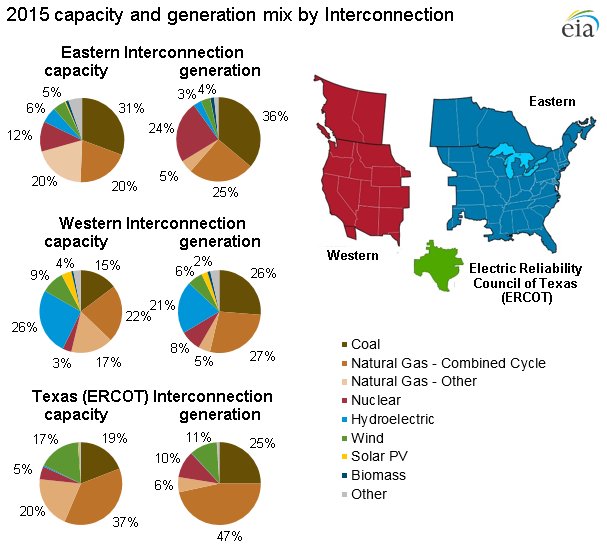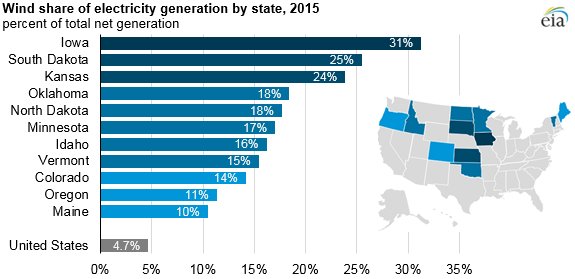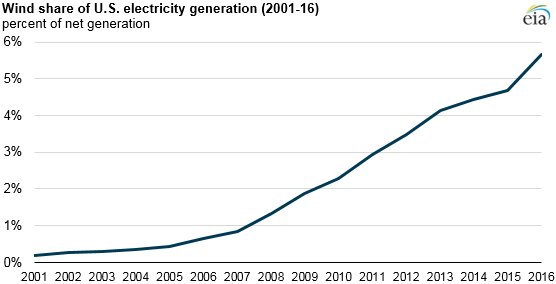
The big takeaway: for those states in the east that mandate renewable energy, they have quite a ways to go, and it's going to be very, very expensive. Right now, in the East, only 4% of total energy is generated by wind (5% capacity), and there is no solar. As nuclear energy declines, currently 24% of total generation, something is going to have to replace it. Coal is dead, so that pretty much leaves natural gas.
The second big takeaway: the EIA in this metric, places the entire North Dakota/Minnesota to Oklahoma/Louisiana corridor in the East which tends to skew the energy breakdown a bit. If the Dakotas, Minnesota, and Iowa were put into the West, where at least the Dakotas belong, the wind situation for the East would be catastrophic.
For me this is how it breaks out;
- East: coal and natural gas (Marcellus, Utica), and when nuclear goes away, natural gas will approach 75%, maybe more, of source for generated electricity
- West: coal, natural gas, and a bit of wind, not much solar except as a niche player
- Texas: natural gas (huge; almost 50% generation), coal, and wind; solar, still inconsequential

Note: the big takeaway from the graphic above: California wind -- nada, zilch, nil. Even Texas, with all it's wind, is too low to round up over 0%. At least that's what the graphic is telling me.
The graphic below is pretty "spectacular" until you realize:
- that we are still talking only 6%; as natural gas increases, the "wind percentage" could actually drop
- most of that wind generation is in the West and Texas; almost none in the East; and,
- the US is slowly running out of "locations" for wind energy (for a number of reasons).

************************************
Tiresome
The misinformation provided by warmists has become incredibly tiresome. From Breitbart:
CNBC viewers are being snookered.
The business news network featured an article in the “Sustainable Energy” section of its Website that proclaimed: “Renewables surged past coal in 2015 to become world’s biggest source of electricity: IEA.”
In reading that headline, one might get the impression that wind turbines and solar panels produced more electricity last year than coal. But the fine print actually reveals a very different picture.
The opening paragraph of the article by “Freelance digital reporter” Anmar Frangoul gives a clue as to the sleight of hand being used. Frangoul cites the International Energy Agency (IEA) as reporting that “Renewable energy moved past coal in 2015 to become the biggest source of global electricity capacity.” The key word there is “capacity.”
What’s noteworthy is that capacity is far different from actual production. The average wind turbine has a maximum rated capacity of roughly 2 megawatts. That means, if the wind is blowing between 26-56 mph, the turbine can spin up to its peak generating capacity. In such moments, the wind turbine can produce its full 2 megawatts.
However, wind turbines, like solar panels, offer only intermittent power generation. Wind turbines can only produce power when there is sufficient wind—and when they are not shut down due to cold weather, repairs, or high winds. And solar panels only produce electricity during periods of direct sunlight. Thus, while a wind turbine can have a maximum capacity of 2 megawatts, its typical output may often be far less, or even 0 megawatts (on a windless day).
In contrast, and as the IEA itself notes, coal provided 40.8 percent of worldwide power generation in 2014. The renewables that Frangoul crows about—defined by the IEA as “geothermal, solar, wind, heat, etc.”—produced only 6.3 percent of all power.
Thus we see some of the misleading language in the CNBC article.
Frangoul talks about renewables producing 23 percent of world power generation in 2015—which is only possible when hydropower’s robust 16.4 percent is added to renewables’ paltry 6.3 percent share.
And while the IEA says that “renewables represented more than half the new power capacity around the world” in 2015, one has to remember their frustrating intermittency.
Wind turbines only generate roughly 20 percent of their installed capacity, and solar panels yield an even more meager 10 percent.Much more at the link. Wow, it gets tiresome.
No comments:
Post a Comment